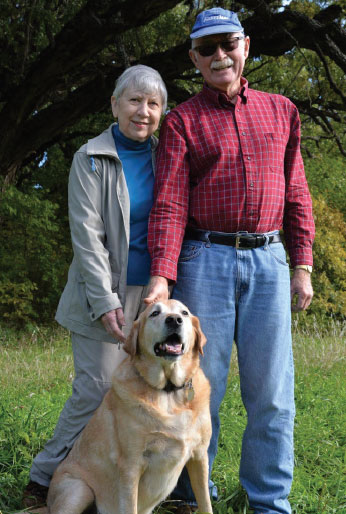Legacy Sanctuaries
Legacy Sanctuaries are properties that have been left to AOK by the owners in their wills. There are many ways you can work with Audubon of Kansas (AOK) to ensure that your land is managed in perpetuity to benefit biodiversity, preserve natural habitat, reflect family history, and maintain the characteristics of a wildlife-friendly working farm, ranch, or other property.
This brochure, which is part of AOK’s Sanctuaries Initiative, describes some of the opportunities available to individuals who want to permanently preserve their land as they wish for the benefit of people and wildlife.
Gary and Carolyn Haden Far West Farm
 Far West Farm comprises two parcels on the western edge of the Flint Hills in Morris County. The properties are owned by Gary and Carolyn (Kendall) Haden, Manhattan. The total acreage of the two parcels is 285 acres—a 73-acre unit spans Clarks Creek, a tributary of the Kansas River, while a 212-acre parcel two miles north lies along and near the east side of Clarks Creek, with six acres being on the west side of the stream. The headwaters of Clarks Creek are a mere two miles to the south of the southern unit of Far West Farm, but in those two miles the stream has grown significantly into a permanent stream due to numerous springs. Beaver dams produce year-around pools.
Far West Farm comprises two parcels on the western edge of the Flint Hills in Morris County. The properties are owned by Gary and Carolyn (Kendall) Haden, Manhattan. The total acreage of the two parcels is 285 acres—a 73-acre unit spans Clarks Creek, a tributary of the Kansas River, while a 212-acre parcel two miles north lies along and near the east side of Clarks Creek, with six acres being on the west side of the stream. The headwaters of Clarks Creek are a mere two miles to the south of the southern unit of Far West Farm, but in those two miles the stream has grown significantly into a permanent stream due to numerous springs. Beaver dams produce year-around pools.
Far West Farm is named for the Far West Post Office, which in 1864 was the most westerly post office in Kansas. Carolyn’s great grandfather, who had come from Kentucky to work on the Santa Fe Trail and then homesteaded a portion of Far West Farm in 1858, was postmaster of that early post office. Carolyn grew up on a farm a mile from the property. Far West Farm is an Audubon of Kansas Legacy Sanctuary, which means it will become part of AOK’s Sanctuary system upon the death of the Hadens-- or possibly before then. The farm contains a variety of wildlife habitats and will serve well as an AOK Wildlife-Friendly Farm. In addition to beaver, white-tailed deer, turkeys, quail, barred owls, wood ducks and numerous other bird species are regulars on both parcels.
The 73-acre parcel that spans Clarks Creek includes a half-mile nature trail that runs along Clarks Creek. It passes alongside a Great Blue Heron rookery before exiting the riparian zone to emerge at an 11-acre hay meadow composed of never-tilled native prairie. The southern parcel includes a mix of tilled fields, hay meadow, a Conservation Reserve Program filter strip and more than 30 acres of woodlands. The most dramatic feature of the land are massive bur oaks that apparently took root shortly after woodlands in the area were cut to construct homes and serve the railroad, which reached the area in 1887.
The northerly parcel, which lies west of Latimer, Kansas, includes nearly 100 acres of pasture that has never been tilled, approximately 70 acres of cropland, CRP filter strips and approximately 35 acres of riparian and other woodlands. A two-acre pond has been surrounded by fence to exclude cattle, which has proven to be a dramatic demonstration of the difference between grazed and ungrazed prairie. Forbs flourish on both the grazed and ungrazed areas and pollinators are particularly abundant on some acreage outside the pasture that is managed for them. Prairie Chickens are frequent visitors to the pasture and pheasants are occasional residents. The abundance of edge habitat seems to be favored by coyotes and secretive bobcats.

